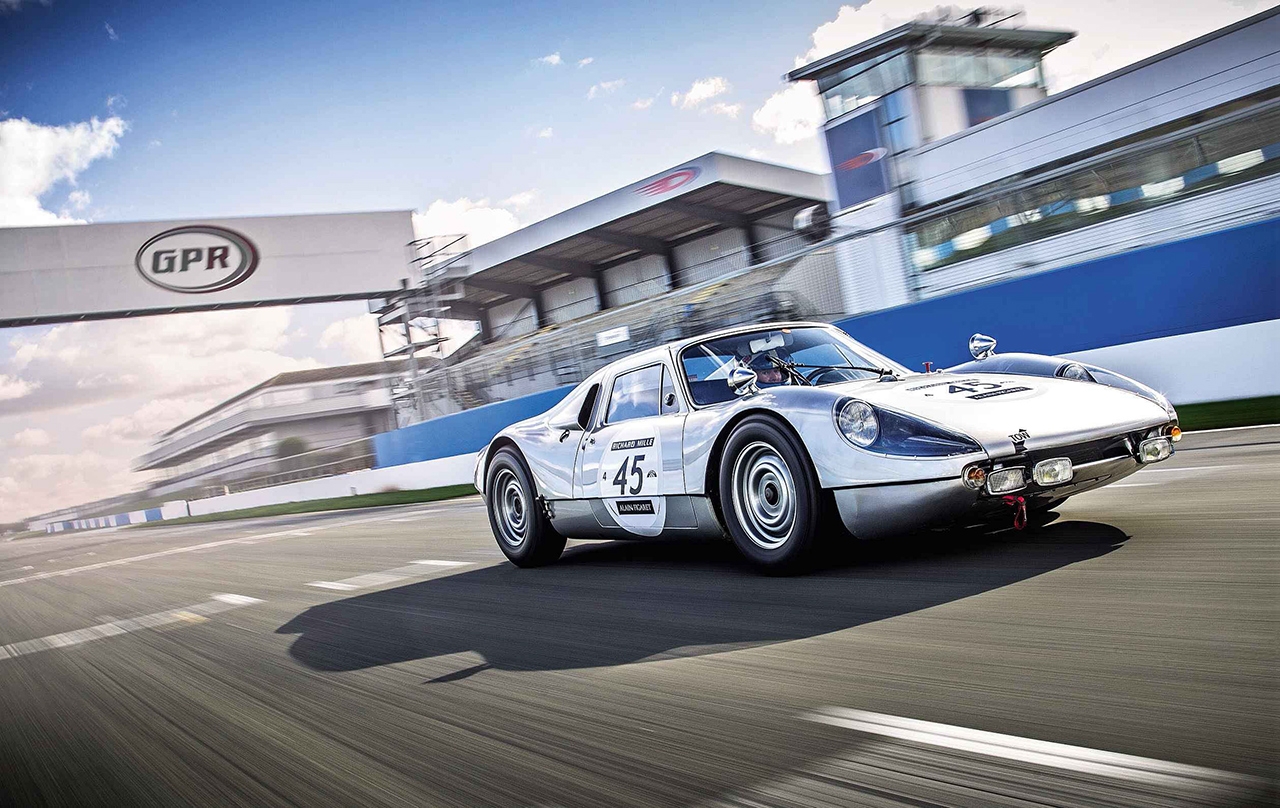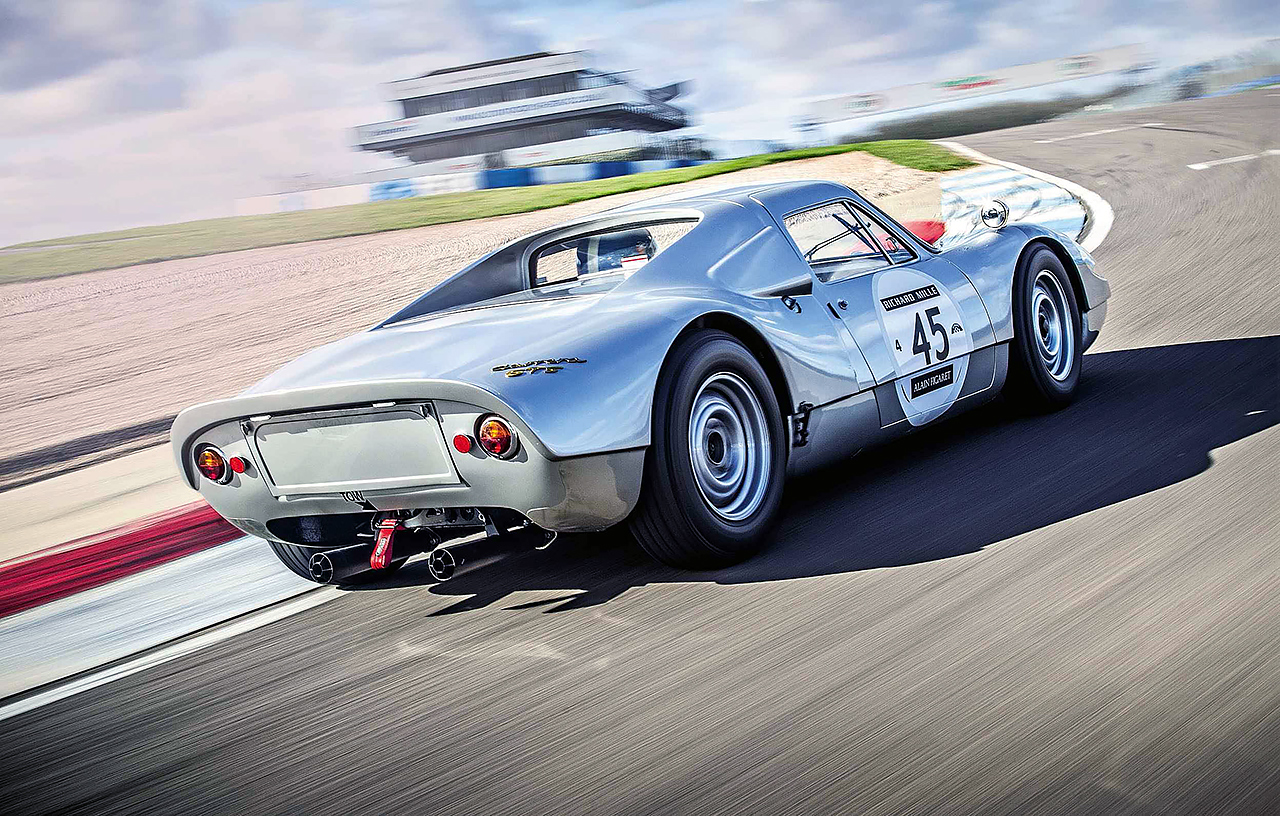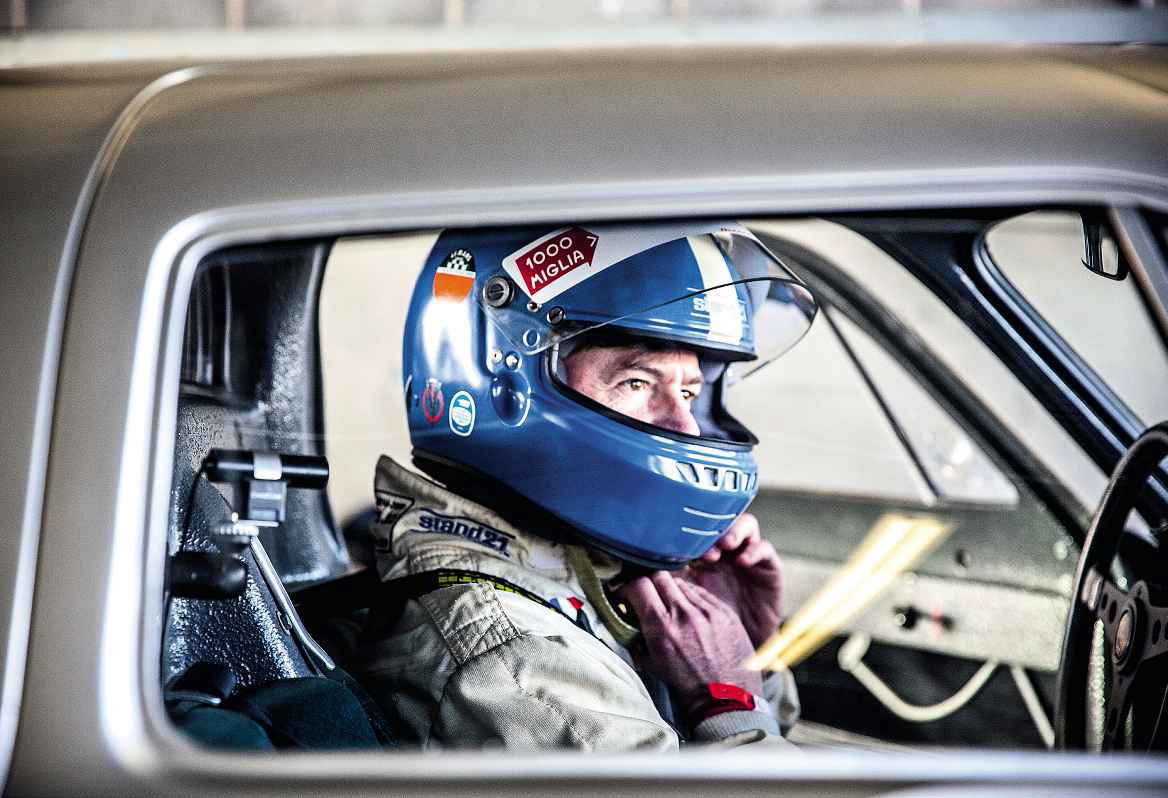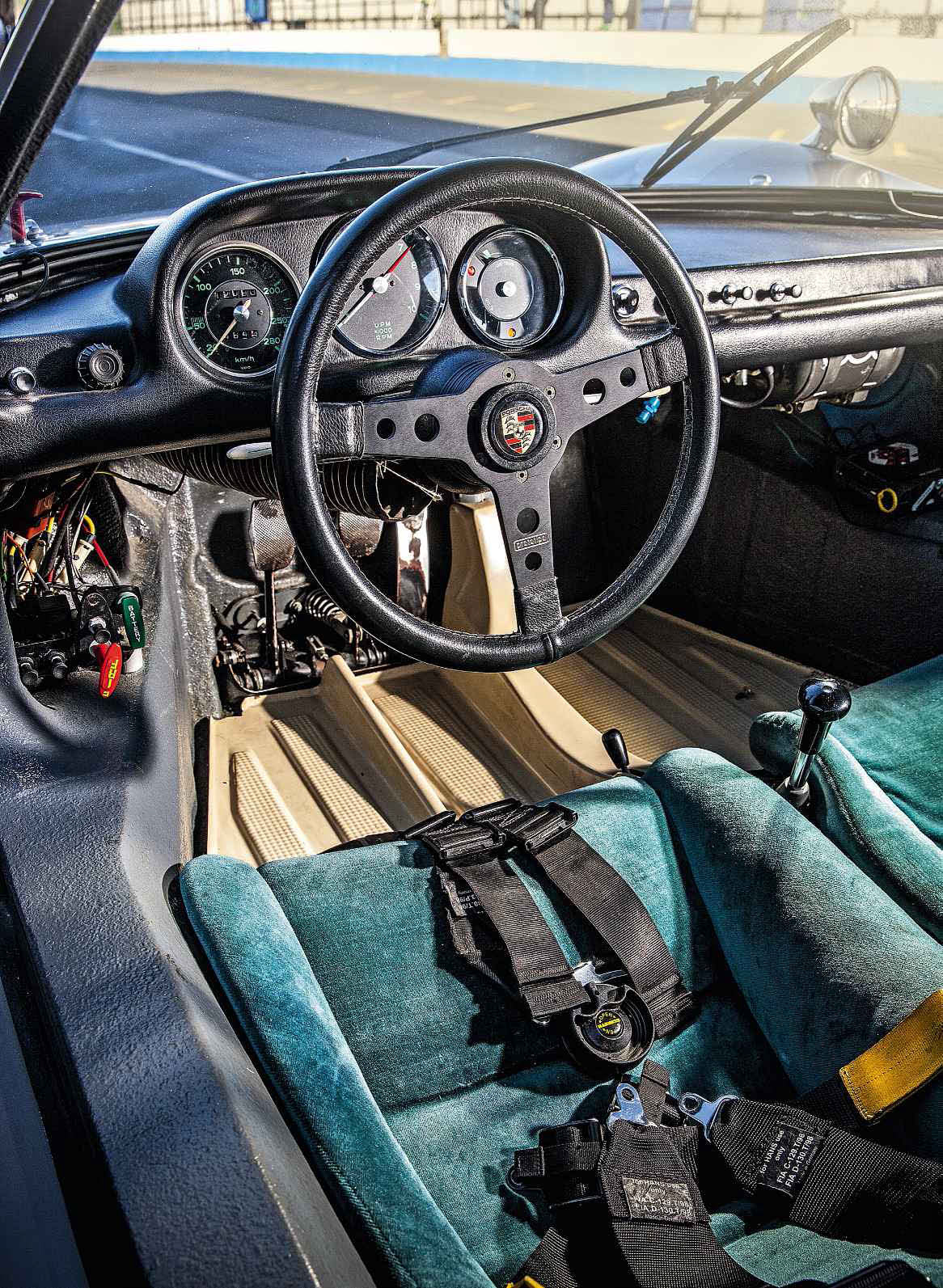
If looks could thrill Porsche 904/6. Track-testing Stuttgart’s rare and beautiful racer. The greatest-looking Porsche ever? It’s certainly one of the most exciting. Robert Coucher tests the rare 904/6 at Donington Park. Photography Charlie Magee.
Just look at this silver projectile hunched low over its fat Avon CR6ZZ tyres, taut bodywork stretched tight and sparingly over the underpinnings, its muscular haunches full of exquisite Porsche mechanicals, the long, long nose with its beautifully faired-in headlamps designed to spear down the road at 160mph, all day and often all night too, accompanied by the most glorious, spine-tingling wail from the two huge exhaust snaps protruding phallically from the rear. An automotive sensation that looks good but performs even better.

1965 Porsche Carrera GTS 904/6 driven
Many would agree that the current range of Porsche sports cars are as good-looking as anything from the Zuffenhausen works’ past. That tradition of great styling began with the Porsche 356, first seen in 1948, which became a study in the evolution of a design, as was the replacement 911, introduced in 1964 and continuing with its DNA still very much recognisable today. As a company deeply immersed in motor racing, Porsche produced a number of functional suppository-shaped projectiles in the 1959s and early 1960s, with successes in Formula 1 and Formula 2 racing, but, at the end of the 1962 season, the company decided to focus on sports car racing. The result was the development of the last Porsche you could race at the highest level yet still use on the road – the Carrera GTS, or 904 as it is usually known. It has to be one of the best-looking Porsches. Ever.
The stunning Porsche Carrera GTS you see here is not one of the 106 lesser-spotted 904s constructed for FIA-GT racing of the time. It’s even rarer: one of only seven 904/6 GTSs, but we will come to that.

So where did this beautiful Carrera GTS left-of-field design spring from, within a very technical and engineeringfocussed company? Well, not a car designer per se but from the pen of a 28-year-old ‘stylist’ who failed to graduate from Germany’s leading design institute at Ulm and who later went into sunglasses and chronograph wristwatches. During his car ‘phase’ he was also credited with styling the 911 – not bad either – and it probably helped that he was Ferdinand Alexander Porsche III, known as ‘Butzi’, son of Ferry Porsche.
Of the Carrera GTS, he told historian Karl Ludvigsen: ‘It was my favourite because I did it alone and there wasn’t this fight to change it or make it newer. It was designed and finished. Time was short.’ Such are the pressures of developing racing cars for the next season and the need to get it right, first off. In the winter of 1962/63 Porsche had committed itself to the urgent development of a new GT racing car along with a limited production of road cars. The result was a sensation.

Right. The 904/6 at Donington Park, fresh from the workshop and ready for shakedown testing. In period, it competed at the Nürburgring, in the Solitude GP and at Mont Ventoux.
Porsche technical director Hans Tomola had always intended the Carrera GTS to be fitted with a race-tuned, twin-plug version of the flat-six 901 engine, which was being developed for the upcoming sports car, but time ran out and it proved not to be properly sorted in time for the GTS. So he turned to the well-proven Fuhrmann Type 587 four-cam, two-litre Carrera 2 flat-four engine instead – probably the most complex four-cylinder ever.
The engine was further developed by Hans Mezger, becoming known as the 587/3 and producing 180bhp at a heady 7200rpm. The road cars, with street-legal exhausts, mustered a more muted 155bhp. This led to the unofficially named 904 (Porsche had a naming issue with Peugeot using the zero in its nomenclature – as with the 901, which became known as the 911).

The radical 904 was the first Porsche to use a ladder-type frame – spaceframe construction was too expensive for what was, in essence, a production car – and glassfibre body, with the manufacturing turned over to Heinkel Flugzeugwerke in Speyer. It was novel in that the rather unevenly sprayed glassfibre body was bonded directly to the steel chassis to add stiffness, the upshot being that it was more rigid than the previous spaceframe cars. Also, the 904 was commendably light at 675kg, its 2mm-thick (give or take) glassfibre shell weighing only 85kg. The shark nose helped give a drag coefficient of 0.34, low for the time, and a top speed of 160mph, after reaching 60mph in 5.5 seconds from rest.
The four-cam engine was mounted amidships in the frame and the sophisticated twin-wishbone and coil-over-damper front suspension with anti-roll bar was taken from the Type 804 F1 car, while the ZF rack-and-pinion was an adaptation of the 901/911 set-up. At the rear, the usual Porsche swing axles were replaced with coils and wishbones, plus lower links braced forwards to the frame with a radius rod and an anti-roll bar. Brakes were ATE discs, very similar to those used on the 356C, deemed sufficient in this lightweight racer.
The all-new 904’s first race was in 1964 at Sebring, driven by Briggs Cunningham to ninth overall and first in the prototype class. From there it went on to place first, second and seventh on the tough Targa Florio, then third at the Nürburgring, seventh overall and first in class at Le Mans, with further class wins at Spa, the 12 Hours of Reims and many others, including a second place in the snow-covered 1965 Monte Carlo rally. A giant-killer indeed.

Left and above. The air-cooled 2.0-litre flat-six is tuned to deliver a buzzing 180bhp – and the car weighs only 675kg! Stripped interior is rational, befitting an endurance racer.
Later that year, Porsche readied its fabulous 180bhp racing version of the 901 flat-six (twin plugs and twin ignition) to fit to the Carrera GTS, with chassis numbers beginning with 906 rather than 904. Only four survive of the seven constructed – before the arrival of the even more racefocused 906 in 1966, with its spaceframe superstructure.
‘THE 904/6 LEAPS OFF THE MARK. IT FEELS LIKE YOU’RE STRAPPED TO THE ENGINE, WITH NO OTHER WEIGHT TO IMPEDE THE TRAJECTORY’
This 904/6 is chassis number 906-011, a factory car, and can be distinguished from the four-cylinder versions by its large central fuel filler cap, vertical window lifts, more efficient brake ducts, foglights and side scoops. The rear deck was handlaid glassfibre, which saved a further 13kg. As with all competitive racing cars, development was continual and rapid in the quest for ultimate performance.
Carrera GTS 906-011 was immediately pressed into action at the Le Mans trials of 1965, with factory driver Gerhardt Mitter. In the same year it finished ninth in the arduous Nürburgring 1000km, driven by Mitter and Colin Davis. It then achieved a superb third at Stuttgart’s Grand Prix of Solitude, driven by Herbert Linge, and came second in France’s Mont Ventoux course de côte, with Mitter again behind the wheel. An impressive collection of trophies.
‘THE RESULT WAS THE LAST PORSCHE YOU COULD RACE AT THE HIGHEST LEVEL YET USE ON THE ROAD. AND IT’S ONE OF THE BEST-LOOKING EVER’
In 1968 it was bought by Porsche dealer and racer Vasek Polak in southern California without an engine. He fitted a 904 four-cam and raced it in numerous SCCA events in A-Production and GT classes at great circuits including Riverside, Laguna Seca, Sears Point, Pacific Raceways, Sebring, Daytona and Watkins Glen.

A full restoration came in 1985, by Gunnar Racing, which fitted a correct twin-plug flat-six. Since then it has been campaigned continuously in classic motor sport events, including Monterey Historics and Rennsport Reunion.
Today we are at Donington Park, where it is bright but bitterly cold. An early pre-season test day sees all sorts of biggun sports prototypes and open-wheelers circulating the fast and undulating track at serious speed. Porsche specialist Andy Prill has invited me along to a first shakedown of the 904/6 fresh out of his Prill Porsche Classics workshop.
In the pits the Carrera GTS looks tiny but perfectly formed. It is painted in the usual Porsche silver and sits on what look like normal early Porsche steel wheels without hubcaps – these are modern magnesium alloy replacements, though still typical of Porsche’s no-nonsense approach to its race preparation. Why have fancy-looking wheels?
While the 904/6 is undoubtedly beautiful, it has a functionality and toughness about it and there’s nothing frivolous anywhere except maybe for the gold-coloured Carrera GTS script offset on the rear lid. And the quartet of extra driving lights, hung out on the nose, and there for a reason. This is an endurance sports car.

Hot-shoe Andy takes the wheel first, firing up the flat-six and gently warming it though. Then he adds a bit of juice via the triple 46IDA Weber carbs and everyone down the pitlane stops and turns around, arrested by the hard metallic bark of this sweet, unfettered 1991cc mill. The sound is fabulous and the car hasn’t even moved yet. Oh woe the new emission-constrained turbocharged lumps found in the latest Porkers.
Andy straps in, hits the tarmac and we hear its sonorous soundtrack all around the 1.979-mile loop of the National circuit as those beautifully hewn exhaust silencers fail to quell its Valkyrie battle cry. Marvellous. He comes in and hops out. ‘The throttle pedal is initially quite sticky but that’s just an adjustment. There’s bugger-all grip out there as I can’t get the tyres up to temperature and the brake bias needs a bit of attention. Other than that, the engine feels smooth through the rev range, but limit it to six thou’ as it’s still running in. OK, now you have a go.’
Great. A stiff throttle, ice-cold tyres, no grip and iffy brakes. How much is it worth? I clamber into the snug cockpit and strap into the fixed blue corduroy-covered bucket seat. The driving position is reclined and the pedals and steering wheel adjust to suit the driver. Feet are offset to the centre but the good-sized pedals are set up perfectly for heel-and-toeing. The firm-rimmed Momo wheel is placed near to vertical but you can see all the VDO instruments clearly. The gearshift is stubby and long of throw with the first on a dogleg, down towards you and back.
With my full-face helmet on, there’s not much headroom but at least it acts as a sound deadener. Give the Webers a pump, hold the throttle down a tad and fire the flat-six. It’s loud in here but the sound is thoroughbred – this is one of the best engines in the world. Its energy fizzes about the cabin but it always remains smooth. The clutch is firm and short in travel; the gearshift is ill-defined and loose but I think I’ve got first. The 904/6 leaps off the mark, thanks to zero flywheel weight, and it feels like you’re strapped directly to the engine, with no other weight to impede the fast-forward trajectory.
The rack-and-pinion steering is ultra-light and direct, and brushing the brakes before the first corner slews speed off immediately in this flyweight package. Time to get a bit braver and bother that recalcitrant throttle pedal. God, it feels screamingly quick, instantaneous, reactive, sharp, balanced and eager. When the butterflies in the Webers open the Porsche literally comes alive. The engine note intensifies and soars and I have to change again and again to stop it singing over the six thou’ limit.
Through the corners the 904/6 initially understeers, which is fine by me, and Andy has advised that the fastest way is to turn-in on braking but keep it neat, with just a bit of slide on the way out. The 904/6 feels a lot better balanced and more manageable than an early 911 of the period and, indeed, could be a very entertaining if loud road car. The only control that’s less than perfect is the gearchange, thanks to its long and tortuous linkage aft, but they’re all like that.
Undoubtedly the 904/6 is one of the best-looking and best-sounding Porsches ever, and to drive this factory racer, with its illustrious competition history, is a rare experience that offers a glimpse into how the Carrera GTS set Porsche onto the path of world endurance sports car racing dominance.
Thanks to owner Cameron Healy; Prill Porsche Classics, www.prillporscheclassics.com; and Donington Park Circuit, www.donington-park.co.uk.
TECHNICAL DATA 1965 Porsche Carrera GTS 904/6
Engine 1991cc flat-six, SOHC, dry sump, dual ignition, two triple 46IDA Weber carburettors
Power 180bhp @ 7200rpm
Torque 160lb ft @ 5500rpm
Transmission Five-speed manual, rearwheel drive
Steering Rack and pinion
Suspension Front: double wishbones, coil-over-damper units, anti-roll bar. Rear: wishbones, coil-over-damper units, lower links, radius rod, anti-roll bar
Brakes Discs, no servo
Weight 675kg
Performance Top speed 160mph / 0-60mph 5.5sec

Left and above. Only seven flat-six-powered 904/6s were built as a development of the original four-cam 904. Butzi Porsche was responsible for its sensational styling.





